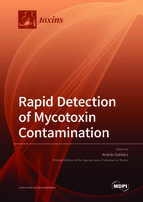Rapid Detection of Mycotoxin Contamination
A special issue of Toxins (ISSN 2072-6651). This special issue belongs to the section "Mycotoxins".
Deadline for manuscript submissions: closed (31 December 2020) | Viewed by 49191
Special Issue Editor
Interests: environmental and food safety; organic microcontaminants (pesticide residues and mycotoxins); environmental analysis; agricultural ecotoxicology; genetic safety
Special Issues, Collections and Topics in MDPI journals
Special Issue Information
Dear Colleagues,
Mycotoxin contamination in crops, and the subsequent mycotoxin contamination in food and feed is currently a major concern in environmental and food safety, affecting both crop production and animal husbandry. In turn, the rapid detection of mycotoxin levels in food and feed, as well as in other biological and environmental matrices, is of key importance both in mycotoxin monitoring and exposure assessment.
Mycotoxin occurrence in produce is mostly as a result of improper harvest or storage conditions that favour the emergence of toxinogenic fungi (e.g., Fusarium, Penicillium, Aspergillus, and other species). Target mycotoxins include the most hazardous aflatoxins, trichothecenes (e.g., T-2, deoxynivalenol), resorcilactones (e.g., zearalenone), fumonisins, and ochratoxins, as well as recently identified compounds (e.g., sterigmatocystin, moniliformin, and others). The meteorological conditions prior to harvest strongly affect fungal growth and mycotoxin production; moreover, climate change also exerts its impact, as toxinogenic fungal strains may now emerge at climatic zones where they could not colonise before.
Our Special Issue of Toxins aims to summarise the importance of mycotoxin detection in various matrices by reporting diverse aspects, hopefully covering a wide range of application, including (but not limited to) the following:
- monitoring the occurrence of mycotoxins in crops and produce, as related to meteorological conditions, including the assessment of the potential effects of climate change trends on mycotoxin occurrence;
- a particular issue related to the abovementioned point is the general and repeatedly refuted allegation of ecological farming, of being a source of mycotoxin contamination because of the prohibition of the use of synthetic fungicides; therefore, the submission of comparative monitoring studies of mycotoxins in conventional and ecological agriculture are welcome;
- decomposition of mycotoxins in biological matrices, because of the effects of natural or artificially accelerated enzymatic conditions;
- effect-based monitoring of mycotoxins in affected animals, as well as veterinary mycotoxin analyses;
- assessment of mycotoxin decontamination methods aiming to suppress emerging mycotoxin poisoning;
- novel or inventive methods of mycotoxin analysis, including chromatography, immunoassay, molecular biology, sensorics, and other means, including novel sample preparation methods (e.g., QuEChERS and immunoaffinity pre-purification);
- methods of toxicological or ecotoxicological assessment, including cytotoxicity, genotoxicity, mutagenicity, and endocrine disruption, combined with chemical analysis.
Prof. András Székács
Guest Editor
Manuscript Submission Information
Manuscripts should be submitted online at www.mdpi.com by registering and logging in to this website. Once you are registered, click here to go to the submission form. Manuscripts can be submitted until the deadline. All submissions that pass pre-check are peer-reviewed. Accepted papers will be published continuously in the journal (as soon as accepted) and will be listed together on the special issue website. Research articles, review articles as well as short communications are invited. For planned papers, a title and short abstract (about 100 words) can be sent to the Editorial Office for announcement on this website.
Submitted manuscripts should not have been published previously, nor be under consideration for publication elsewhere (except conference proceedings papers). All manuscripts are thoroughly refereed through a double-blind peer-review process. A guide for authors and other relevant information for submission of manuscripts is available on the Instructions for Authors page. Toxins is an international peer-reviewed open access monthly journal published by MDPI.
Please visit the Instructions for Authors page before submitting a manuscript. The Article Processing Charge (APC) for publication in this open access journal is 2700 CHF (Swiss Francs). Submitted papers should be well formatted and use good English. Authors may use MDPI's English editing service prior to publication or during author revisions.
Keywords
- mycotoxin analysis
- monitoring
- decomposition/metabolism
- decontamination
- instrumental and immunoanalysis
- sensorics
- cytotoxicity
- genotoxicity
- mutagenicity
- endocrine disruption







